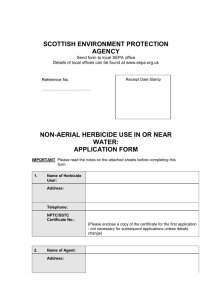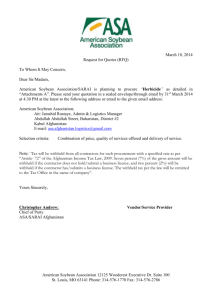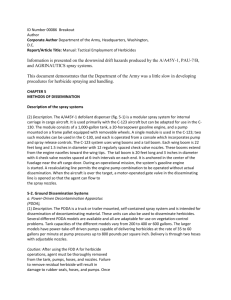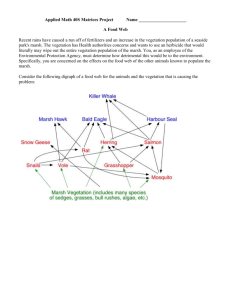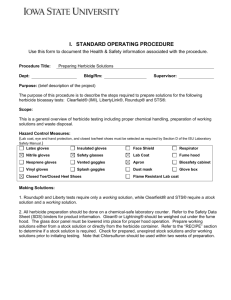Effect of Surfactants and Adjuvants on Postemergence Herbicide Efficacy
advertisement
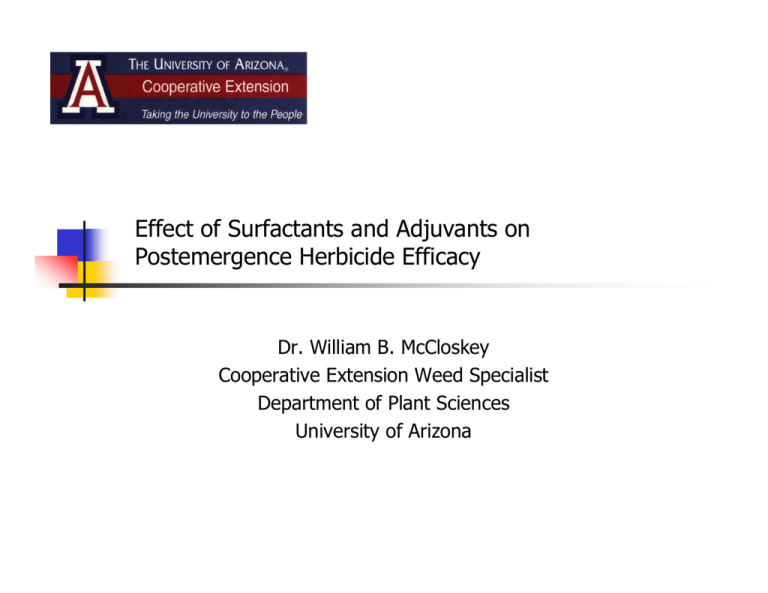
Effect of Surfactants and Adjuvants on Postemergence Herbicide Efficacy Dr. William B. McCloskey Cooperative Extension Weed Specialist Department of Plant Sciences University of Arizona Plant – Herbicide Interactions Herbicide Uptake – Shoots To be effective in killing weeds, postemergence herbicides must: Come in contact with a plant surface, primarily leaves, Be retained on the plant surface long enough to penetrate or be absorbed into the plant, and Reach a living, cellular site where the herbicide can disrupt a vital process or structure. What are the characteristics of plant surfaces that affect herbicide absorption? Plant – Herbicide Interactions Herbicide Uptake – Shoots – Cuticle To protect against water loss and desiccation, plant epidermal surfaces are covered by a cuticle. It is important to note that the cuticle is present on the upper and lower leaf surfaces and on the surface of all cells that line sub-stomatal cavities. Plant – Herbicide Interactions Herbicide Uptake – Leaf Cuticle The major barrier to postemergence herbicide absorption is the cuticle which is composed of three types of materials. Wax Cutin Pectins Plant – Herbicide Interactions Herbicide Uptake – Leaf Cuticle The major barrier to postemergence herbicide absorption is the cuticle which is composed of three types of materials. Wax - long hydrocarbon (C20 - C37) chains that include some fatty acids. Epicuticular wax - wax on the cuticle/leaf surface Embedded wax - wax within the cuticle layers Waxes are non-polar or oil-like (lipophilic) and form an effective water repellent layer over the entire shoot surface. A lipid (oil-like) soluble, long chain hydrocarbon CH3 – (CH2)n – The higher the number of CH2 (i.e., n), the more wax-like the hydrocarbon Plant – Herbicide Interactions Herbicide Uptake – Leaf Cuticle The major barrier to postemergence herbicide absorption is the cuticle which is composed of three types of materials. Wax - long hydrocarbon (C20 - C37) chains that include some fatty acids. Cutin - intermediate length hydrocarbon (C16 - C18) fatty acids. Lipophilic however cutin also contains free carboxyl (–COOH / –COO-) and hydroxyl (–OH / –O-) groups that ionize making the cutin more compatible with water (i.e., hydrophilic) than wax. Its important to remember that the cutin becomes hydrated in the presence of water when considering the effect of plant water stress on herbicide absorption (sponge analogy). Plant – Herbicide Interactions Herbicide Uptake – Leaf Cuticle The major barrier to postemergence herbicide absorption is the cuticle which is composed of three types of materials. Wax - long hydrocarbon (C20 - C37) chains that include some fatty acids. Cutin - intermediate length hydrocarbon (C16 - C18) fatty acids. Pectin - polymers of galacturonic acid that form strands that are either at the cutin-cell wall interface or are interspersed in the cutin layer. Pectin has many carboxyl groups making it the most hydrophilic of the cuticle components. When hydrated, pectin strands can provide aqueous pathways for the uptake of water-soluble herbicides. Plant water stress affects the degree of hydration of pectin. Plant – Herbicide Interactions Herbicide Uptake – Leaf Cuticle Overall the cuticle is lipophilic and carries a negative charge due to the charged groups (–COO- and –O-) on cutin (fatty acids) and pectin (galacturonic acid). The presence of waxes at the exterior of the cuticle results in an extremely lipophilic or hydrophobic layer that forms a barrier to water movement. Restricts water loss from leaf surfaces to water vapor loss through the stomates allowing plants regulate their water use. Restricts the entry of water soluble compounds through the leaf epidermis but not oil soluble compounds. Plant – Herbicide Interactions Herbicide Uptake – Leaf Cuticle Gradient in lipophilic-hydrophilic properties Lipophilic gradient Hydrophilic Cell wall is hydrophilic and is hydrated Plant – Herbicide Interactions Herbicide Uptake – The Nature Of Water Water is a polar substance due to the asymmetric sharing of electrons between oxygen and hydrogen. Water is a good general solvent, in part due to the small size of its molecules. Water’s high dielectric constant makes it a particularly appropriate solvent for ions. In contrast, hydrocarbons composed of carbon and hydrogen are nonpolar because electrons are shared equally between carbon and hydrogen. Plant – Herbicide Interactions Herbicide Uptake – The Nature Of Water Orientation of water molecules around a K+ indicating the charge arrangement that leads to screening of the local electrical field. Water is a good general solvent, in part due to the small size of its molecules. Water’s high dielectric constant makes it a particularly appropriate solvent for ions. In contrast, water is not a good solvent for hydrocarbon molecules. When hydrocarbons or oillike molecules are mixed, they separate into different phases. oil water Plant – Herbicide Interactions Herbicide Uptake – The Nature Of Water Water is the most commonly used herbicide carrier because it is cheap and readily available. Water has a high surface tension and beads on waxy surfaces because of its polar nature. As a consequence: Aqueous herbicide solutions do not usually spread out on leaf surfaces, and Aqueous herbicide spray drops frequently bounce off or run off leaf and stem surfaces. Adequate retention of aqueous sprays on aerial plant surfaces is difficult to obtain and requires that spray solutions be modified to wet the waxy cuticle. What are the characteristics of plant surfaces that affect herbicide absorption? Plant – Herbicide Interactions Herbicide Uptake – Leaf Surfaces Common Lambsquarters (Chenopodium album L.). Light microscope – 35X Plant – Herbicide Interactions Herbicide Uptake – Leaf Surfaces Common Lambsquarters leaf surface. Scanning electron microscope – 70X Scanning electron microscope – 350X Plant – Herbicide Interactions Herbicide Uptake – Leaf Surfaces Common Lambsquarters leaf surface. Scanning electron microscope – 3500X Note epicuticular wax Plant – Herbicide Interactions Herbicide Uptake – Leaf Surfaces Redroot pigweed (Amaranthus retroflexus L.). Upper leaf surface Light microscope – 35X Plant – Herbicide Interactions Herbicide Uptake – Leaf Surfaces Redroot pigweed upper leaf surface. Scanning electron microscope – 70X Scanning electron microscope – 350X Plant – Herbicide Interactions Herbicide Uptake – Leaf Surfaces Redroot pigweed upper leaf surface. Scanning electron microscope – 3500X Plant – Herbicide Interactions Herbicide Uptake – Leaf Surfaces Johnsongrass (Sorghum halepense L. Pers.). Upper leaf surface Light microscope – 35X Plant – Herbicide Interactions Herbicide Uptake – Leaf Surfaces Johnsongrass upper leaf surface. Scanning electron microscope – 70X Scanning electron microscope – 350X Plant – Herbicide Interactions Herbicide Uptake – Leaf Surfaces Johnsongrass upper leaf surface. Scanning electron microscope – 3500X Note epicuticular wax that is characteristic of many grasses. Plant – Herbicide Interactions Herbicide Uptake – Leaf Surfaces Purple nutsedge (Cyperus rotundus L.). Upper leaf surface Light microscope – 35X Plant – Herbicide Interactions Herbicide Uptake – Leaf Surfaces Purple nutsedge upper leaf surface. Scanning electron microscope – 70X Scanning electron microscope – 350X Plant – Herbicide Interactions Herbicide Uptake – Leaf Surfaces Purple nutsedge upper leaf surface. Scanning electron microscope – 3500X Plant – Herbicide Interactions Herbicide Uptake – Leaf Surfaces The movement or absorption of herbicide into leaves depends on herbicide spray retention on the leaf surface and on diffusion through the cuticle (i.e., cuticular penetration). Several factors influence the retention and distribution of herbicide on plant surfaces. The inherent wettability of the leaf surface. The amount of epicuticular and cuticular wax and the physical structure of the wax. The hairiness (number of trichomes) on the leaf surface. Plant – Herbicide Interactions Herbicide Uptake – Leaf Surfaces In addition to waxes, leaf surfaces sometimes have trichomes or hairs that reduce the absorption or uptake of herbicides. A dense covering of trichomes can suspend spray droplets above the leaf surface preventing herbicide absorption (scanning electron micrographs). Trichomes (hairs) on common mullein Trichomes (hairs) on velvetleaf Plant – Herbicide Interactions Herbicide Uptake – Leaf Surfaces Scanning electron micrograph of MCPA (sodium salt) deposits on Eremocarpus setigerus leaves. The secondary electron image has been superimposed on a cathodoluminescence image, showing the herbicide as a light-colored deposit. The arrows indicate the herbicide that has penetrated through the leaf hairs to the epidermal surface. Scale bar = 200 µm. Plant – Herbicide Interactions Herbicide Uptake – Leaf Surfaces The movement or absorption of herbicide into leaves depends on herbicide spray retention on the leaf surface and on diffusion through the cuticle (i.e., cuticular penetration). Several factors influence the retention and distribution of herbicide on plant surfaces. The inherent wettability of the leaf surface. The amount of cuticular wax and the physical structure of the wax. The hairiness (number of trichomes) on the leaf surface. The surface tension of the spray solution. Because of the high surface tension of water, adequate retention of aqueous sprays on the plant surfaces usually requires that spray solutions be modified to wet the waxy cuticle. Plant – Herbicide Interactions Herbicide Uptake – Spray Adjuvants When a spray droplet lands on a leaf or other plant surface it may be retained on the plant surface or bounce off the surface and ultimately land on some other plant part or the soil. Droplets with high dynamic surface tension are more likely to roll or bounce off leaf surfaces. In contrast, droplets with low dynamic surface tension are more likely to be retained on plant surfaces. Without wetting agent or surfactant With wetting agent or surfactant Plant – Herbicide Interactions Herbicide Uptake – Spray Adjuvants The addition of surfactants or wetting agents (e.g., non-ionic surfactants and crop oil concentrates) reduces the dynamic surface tension of water droplets. Reducing dynamic surface tension allows spray droplets to spread out upon impact and increase the area of contact with the plant surface. Reduced dynamic surface tension and increased area of contact reduces the propensity for spray droplets to bounce or roll off plant surfaces. Plant – Herbicide Interactions Herbicide Uptake – Spray Adjuvants When wetting agents or surfactants are added to water they preferentially aggregate at the air-water surface and reduce the surface tension of water. Hydrocarbon (lipophilic, hydrophobic) chain Polar head group When surfactant molecules dissolve in water they form colloidal rather than true solutions by forming aggregates of molecules called micelles. The concentration when micelles begin to form is called the critical micelle concentration. Plant – Herbicide Interactions Herbicide Uptake – Spray Adjuvants Surfactant molecules will surround oil droplets or oil-like substances such as lipophilic herbicide molecules to form “oil-in-water” suspensions or emulsions. The hydrocarbon tails of surfactant molecules associate with the lipophilic portions of suspended molecules while the hydrophilic, polar head of the surfactant molecules associates with water and stabilizes the molecular aggregation in water. Plant – Herbicide Interactions Herbicide Uptake – Spray Adjuvants Crop oil concentrates (COC) are another class of surfactant molecules. Crop oils will not mix with water and will not form stable oil-in-water suspensions. All COC used as spray adjuvants must contain emulsifiers; high quality COC usually contain 15 to 20% emulsifier. The emulsifiers are similar to surfactant molecules. The hydrocarbon tails of emulsifier molecules associate with the suspended oil droplets while the hydrophilic, polar head of the surfactant molecules associates with water and stabilizes the oil-inwater suspension. Lipophilic herbicides partition into the oil phase. Plant – Herbicide Interactions Herbicide Uptake – Spray Adjuvants The addition of surfactants or wetting agents (e.g., non-ionic surfactants and crop oil concentrates) reduces the surface tension of water droplets which allows them to spread out thereby increasing contact with the plant surface. Critical micelle concentration is about 0.1% v/v. Plant – Herbicide Interactions Herbicide Uptake – Spray Adjuvants Wetting agents and surfactants aid foliar herbicide absorption by: Reducing the dynamic surface tension of droplets results in a more uniform spreading of the spray solution and a uniform wetting of the plant. Reducing the dynamic surface tension of droplets improves retention of spray droplets on plant surfaces, resulting in less droplet runoff. Reduce dynamic surface tension of droplets reduces the suspension of spray droplets on hairs, scales or other surface projections and increases spray droplet contact with the leaf surface. Reduce crystallization of the active ingredient on the leaf surface by being a solvent. Slow the drying of, and increasing the water retention in, spray droplets that are on the leaf surface. Plant – Herbicide Interactions Herbicide Uptake – Spray Adjuvants Surfactants aid absorption by reducing the rate of spray droplet drying and crystallization of herbicide. Greater herbicide absorption occurs from amorphous deposits compared to crystalline deposits Plant – Herbicide Interactions Herbicide Uptake – Spray Adjuvants Scanning electron micrograph of clopyralid crystals on Fagopyrum tataricum (formulated in distilled water). Scanning electron micrograph of glyphosate crystals and amorphous deposits on Fagopyrum tataricum (formulated in 0.1% Tween 20). Plant – Herbicide Interactions Herbicide Uptake – Spray Adjuvants Scanning electron micropgraphs of propanil deposits on sugar beet (Beta vulgaris) leaves, following the application of two emulsifiable concentrate formulations. The formulation that formed the more amorphous deposit (LEFT) provided greater control of barnyardgrass (Echinochloa crus-galli). Plant – Herbicide Interactions Herbicide Uptake – Spray Characteristics Several factors influence the retention and distribution of herbicide on plant surfaces. The inherent wettability of the leaf surface. The amount of cuticular wax and the physical structure of the wax. The hairiness (number of trichomes) on the leaf surface. The surface tension of the spray droplets. Spray droplet size, number of droplets and carrier volume effects on: Impaction (spray droplet impact on leaf surface), and Spray droplet retention. Plant – Herbicide Interactions Herbicide Uptake – Spray Adjuvants Most common surfactants for agricultural use are nonionic and anionic surfactants. Oils used as adjuvants include mineral oils, seed oils, and methylated seed oils. Order of effectiveness = mineral oils > methylated crop oils > crop oils. More lipophilic than nonionic surfactants and improve cuticle penetration of more lipophilic herbicides. Another important class of surfactants are organosilicone surfactants. Reduce surface tension more than other surfactants. Some reduce surface tension enough to induce direct stomatal infiltration. Cause more droplet spreading (increases evaporative surface area and can lead to rapid drop drying and reduced absorption). Can be unstable if spray solution pH is not between 6 to 8. Plant – Herbicide Interactions Herbicide Uptake – Spray Adjuvants Spray Adjuvants also include: Salts of fertilizers – primarily ammonium sulfate Reduce precipitation or crystallization of herbicides such as glyphosate on the plant surface. Counteracts antagonisms with components that reduce herbicide activity. Formation of ammonium salts of herbicides that more freely diffuse across the cuticle than inorganic salts (e.g., sodium or potassium salts). Humectants – not extensively used in commercial herbicide applications. Buffers – most common buffers contain phosphoric acid. Glyphosate Complexes With Divalent Cations Glyphosate isopropylamine salt pH > 7 Ca++ or other divalent cations Ca++ Glyphosate-calcium complex that is poorly absorbed by plants. Thelen et. al. 1995 Weed Sci. 43:541-548 Glyphosate and Ammonium Sulfate Glyphosate isopropylamine salt (NH4)2SO4 ammonium sulfate CaSO4 NH4+ NH4-glyphosate complex that is readily absorbed by plants. Thelen et. al. 1995 Weed Sci. 43:541-548 Plant – Herbicide Interactions Herbicide Uptake – Spray Adjuvants Surfactants Aid Absorption By: Causing a more uniform spreading of the spray solution and a uniform wetting of the plant. Help spray droplets stick to the plant, resulting in less runoff. Assuring that droplets do not remain suspended on hairs, scales or other surface projections. Preventing crystallization of the active ingredient on the leaf surface by being a solvent. Slowing the drying of, and increasing the water retention in, spray droplets that are on the leaf surface. Partially solubilizing the lipid plant cuticle substances (controversial). Plant – Herbicide Interactions Herbicide Uptake – Spray Adjuvants The addition of surfactants or wetting agents (e.g., non-ionic surfactants and crop oil concentrates) reduces the surface tension of water droplets which allows them to spread out thereby increasing contact with the plant surface. Critical micelle concentration is about 0.1% v/v. However, surfactant effects on herbicide performance are observed at higher concentrations. These effects are thought to be due to: Reduced rebound of spray droplets from leaf surfaces, and Enhanced herbicide penetration of the cuticle. Plant – Herbicide Interactions Herbicide Uptake – Cuticular Penetration Once a herbicide is distributed on leaf surfaces in spray droplets, it must move through the nonliving cuticle. The driving force for this movement is simple diffusion. Plant – Herbicide Interactions Herbicide Uptake – Cuticular Penetration Lipophilic herbicides are able to penetrate through the cuticular barrier by simple diffusion through the dominant lipophilic components. The rate of herbicide movement depends on solubility or permeance in the cuticle and the driving force (i.e., diffusion gradient). Plant – Herbicide Interactions Herbicide Uptake – Cuticular Penetration Water soluble (hydrophilic) herbicides also enter the cuticle surface through diffusion but the rate of movement is much less than lipophilic herbicides due to their low solubility or permeance within the cuticle. Plant – Herbicide Interactions Herbicide Uptake – Cuticular Penetration Water soluble (hydrophilic) herbicides also enter the cuticle surface through diffusion but the rate of movement is much less than lipophilic herbicides due to their low solubility or permeance within the cuticle. This reduced permeance results in less total herbicide being absorbed. The epicuticular waxes are the most significant barrier to absorption of water soluble herbicides. Once diffusion has occurred across the epicuticular wax, there are hydrophilic cuticular components composed of cutin with its free hydroxyl and carboxyl groups and pectin strands along or through which water soluble herbicides can diffuse. The cuticle is also hydrated and this water also forms a hydrophilic component to the cuticle for diffusion of water soluble herbicides. Plant – Herbicide Interactions Herbicide Uptake – Cuticular Penetration An important action of adjuvants is their penetration into the plant cuticle. Penetration is greatest for lipophilic nonionic surfactants Lipophilic nonionic surfactants increase the fluidity of waxes in the cuticle. Increase the rate of diffusion of oil soluble or lipophilic herbicides across the cuticle. Hydrophilic nonionic surfactants appear to increase the water permeability of the cuticle and the hydration state of the cuticle. Increases the rate of diffusion of water soluble herbicides across the cuticle. Plant – Herbicide Interactions Herbicide Uptake – Spray Adjuvants The overall action of surfactants and other adjuvants in enhancing herbicide absorption is complex and no doubt due to several factors. Stock and Holloway (1993). “Different surfactants do different things to different agrichemicals on different target species.”
